Sequence Features and Transcriptional Stalling within Centromere DNA Promote Establishment of CENP-A Chromatin
The kinetochore directs the separation of chromosomes and is assembled at a special region of the chromosome—the centromere. DNA is wrapped around particles called nucleosomes, which contain histone proteins. The nucleosomes at centromeres are specialized, and contain the centromere-specific histone CENP-A. CENP-A nucleosomes form the platform upon which the kinetochore is built. Thus, CENP-A and centromere function go hand-in-hand. How the cell ensures that CENP-A is deposited at centromeres and not elsewhere is not well understood. We investigated the role that DNA sequence plays in defining centromere function in fission yeast. Our observations suggest that it is not the DNA sequence per se that is important for attracting CENP-A, but rather, the particular environment that the sequence creates. During transcription of centromeric DNA, RNA polymerase (RNAPII) appears to get stuck or stalled. Particular proteins—such as TFIIS and Ubp3—are known to help restart RNAPII so it can continue transcribing. We found that when cells lack Ubp3 or TFIIS, CENP-A becomes deposited on centromere sequences. We propose that persistent stalling of RNAPII on centromere DNA attracts factors that help deposit CENP-A. This study highlights the influence of DNA sequence in creating an attractive environment for CENP-A assembly.
Published in the journal:
. PLoS Genet 11(3): e32767. doi:10.1371/journal.pgen.1004986
Category:
Research Article
doi:
https://doi.org/10.1371/journal.pgen.1004986
Summary
The kinetochore directs the separation of chromosomes and is assembled at a special region of the chromosome—the centromere. DNA is wrapped around particles called nucleosomes, which contain histone proteins. The nucleosomes at centromeres are specialized, and contain the centromere-specific histone CENP-A. CENP-A nucleosomes form the platform upon which the kinetochore is built. Thus, CENP-A and centromere function go hand-in-hand. How the cell ensures that CENP-A is deposited at centromeres and not elsewhere is not well understood. We investigated the role that DNA sequence plays in defining centromere function in fission yeast. Our observations suggest that it is not the DNA sequence per se that is important for attracting CENP-A, but rather, the particular environment that the sequence creates. During transcription of centromeric DNA, RNA polymerase (RNAPII) appears to get stuck or stalled. Particular proteins—such as TFIIS and Ubp3—are known to help restart RNAPII so it can continue transcribing. We found that when cells lack Ubp3 or TFIIS, CENP-A becomes deposited on centromere sequences. We propose that persistent stalling of RNAPII on centromere DNA attracts factors that help deposit CENP-A. This study highlights the influence of DNA sequence in creating an attractive environment for CENP-A assembly.
Introduction
Centromeres are the chromosomal sites upon which kinetochores are assembled to ensure accurate segregation of sister chromatids into daughter cells. Most kinetochores are built upon a specialized type of chromatin in which canonical histone H3 is replaced by the histone variant CENP-A. Although the centromere-kinetochore complex performs conserved essential functions, and kinetochore proteins are generally conserved [1], centromeric DNA is not conserved, even between related species, and a huge variety of centromere sequences and structures exist [2–5]. The point centromeres of budding yeast consist of 125 bp of DNA and utilize an essential centromere-specific DNA binding protein [6]. At the other extreme, the nematode, Caenorhabditis elegans, has holocentric centromeres, in which kinetochore proteins assemble at multiple loci along each chromosome arm [7,8]. The majority of centromeres studied to date are regional. Centromeres in various plant and animal species are composed of arrays of different types of satellite, repetitive sequences and transposable elements, for instance, human centromeres encompass several megabases of tandem repetitive arrays of alpha-satellite sequence [9–11]. Fission yeast centromeres represent another type of regional centromere, in which a unique central core of 4–7 kb is flanked by inverted repeat elements and blocks of relatively large repeat units, resulting in centromeres of 40–120 kb [12]. Even the centromeres of different chromosomes in individual species are not necessarily homologous; each Candida albicans centromere has a unique central core, whilst chicken and potato each utilize both repeat-rich and unique sequence centromeres [13–15]. Thus, functional centromeres are assembled on diverse types of sequences in different organisms and it remains unknown if there is a universal fundamental property that defines centromeric sequences.
Abundant evidence indicates that centromeres are epigenetically regulated [16]. Although rare, neocentromeres have been observed in many species, forming on DNA sequences that do not normally possess centromere function and share no sequence homology with normal centromeres [17]. The best-characterized example in human is the neocentromere in 10q25 on the long arm of chromosome 10 that arose upon deletion of the centromere and loss of the entire alpha satellite array [18]. In S. pombe, neocentromeres form in close proximity to telomeres following the engineered deletion of a centromere [19]. Conversely, centromeres can be inactivated on dicentric human chromosomes despite the continued presence of alpha-satellite sequence at both centromeric loci [20]. In S. pombe one centromere on a dicentric chromosome can be inactivated by mechanisms such as heterochromatinisation or formation of a domain of histone hypoacetylation [21]. These and numerous other examples demonstrate that centromeric sequences are neither necessary nor sufficient for kinetochore assembly.
The histone H3 variant, CENP-A acts as the epigenetic mark that specifies centromere identity [22–24]. CENP-A is found only at active centromeres, including neocentromeres, and is absent at inactivated centromeres. The forced recruitment of CENP-A either by directly tethering CENP-A or its chaperone (HJURP) to a non-centromeric locus leads to the accumulation of CENP-A and kinetochore proteins at that location [24,25]. It is thought that continued deposition of CENP-A at centromere regions through cell and organism generations involves a self-propagation mechanism in which CENP-A chromatin, or features of the kinetochore which is assembled upon it, are recognized and attract additional CENP-A [26,27].
In most organisms there is no obligate coupling of sequence and CENP-A assembly, yet kinetochores are normally assembled upon particular centromeric sequences in any given species [4]. This suggests that centromeric sequences possess underlying properties that promote CENP-A incorporation. Alternatively, the preponderance of particular sequences at centromeres could be driven by properties of CENP-A chromatin or kinetochores themselves [28]. However, centromeric DNA allows the de novo assembly of functional centromeres following its introduction into cells in many organisms. Alpha satellite arrays are able to direct the de novo assembly of centromeres when introduced into certain cell lines as naked DNA [29,30]. De novo assembly of centromeres also occurs when centromeric DNA from S. pombe is introduced into cells. However, de novo establishment does not seem to be a universal property: despite promiscuous neocentromere formation in C. albicans, transformation with bone fide centromeric sequences does not result in kinetochore assembly[13]. At the other extreme, many sequences introduced into the holocentric organism C. elegans appear able to assemble CENP-A chromatin [31,32]. Thus, the relationship between centromeric sequence and the establishment and maintenance of CENP-A chromatin is enigmatic.
Transcription has received a lot of attention as a possible contributor to assembly of CENP-A chromatin. Transcripts emanating from centromeric regions have been detected in many organisms, including maize, human, rice, budding yeast, fission yeast and tammar wallaby [33–38]. Interfering with the chromatin status or transcriptional properties of centromeric repeats affects maintenance of CENP-A chromatin and segregation function on human artificial chromosomes (HACs) [39,40]. RNA Polymerase II (RNAPII) has been detected at mitotic mammalian centromeres where it may influence centromere function [38]. In fission yeast, transient H2B ubiquitylation may loosen centromeric chromatin to promote transcription and CENP-ACnp1 incorporation and defective reassembly of H3 chromatin behind elongating RNAPII aids CENP-ACnp1 incorporation [41,42]. However, although there are numerous tantalising hints that transcriptional activity contributes to centromere function or identity, much remains to be understood [33,38,43,44].
Here we investigate the contribution of DNA sequence to the establishment of CENP-A chromatin in fission yeast, an organism in which epigenetic mechanisms clearly influence centromere identity. Normally proximal heterochromatin is required to facilitate establishment of CENP-ACnp1 chromatin on centromere central domain sequences [45,46]. We show that this requirement can be bypassed by overexpression of CENP-ACnp1 and that central domain DNA is a preferred substrate for establishment of CENP-ACnp1 chromatin. We find that there is functional redundancy within the central domain but that sub-regions are non-equivalent in their ability to establish CENP-ACnp1 chromatin. Analysis of a 2 kb region capable of directing CENP-ACnp1 assembly indicates that it contains numerous transcriptional start sites, along with promoter elements, and that relatively high levels of RNAPII are recruited, despite low levels of transcripts produced, consistent with the presence of stalled RNAPII. Our observations suggest that redundant sequence features in the centromere central domain create a unique transcriptional environment that is permissive for CENP-ACnp1 establishment. Consistent with this, defective transcriptional elongation where stalled RNAPII is increased promotes the establishment of CENP-ACnp1 chromatin.
Results
Elevated CENP-ACnp1 levels bypass the requirement for heterochromatin in establishing CENP-ACnp1 chromatin
In wild-type fission yeast cells, de novo CENP-ACnp1 chromatin establishment on circular plasmid-based minichromosomes requires an outer repeat or tethered Clr4 histone H3K9 methyltransferase to form a block of heterochromatin in close proximity to central domain DNA from centromeres [45,46]. CENP-ACnp1 can also be deposited at other non-centromeric locations in the genome when it is overexpressed, however the level incorporated at these ectopic sites is much lower than that detected at natural centromeres [41,47]. To determine whether central domain DNA is a preferential substrate for the establishment of CENP-ACnp1 chromatin, plasmid pMcc2 bearing 8.5 kb of central domain from cen2 (imr2-cc2-imr2) sequence, but no heterochromatic outer repeat sequences, was transformed into cells expressing additional GFP-CENP-ACnp1 (Fig. 1A).
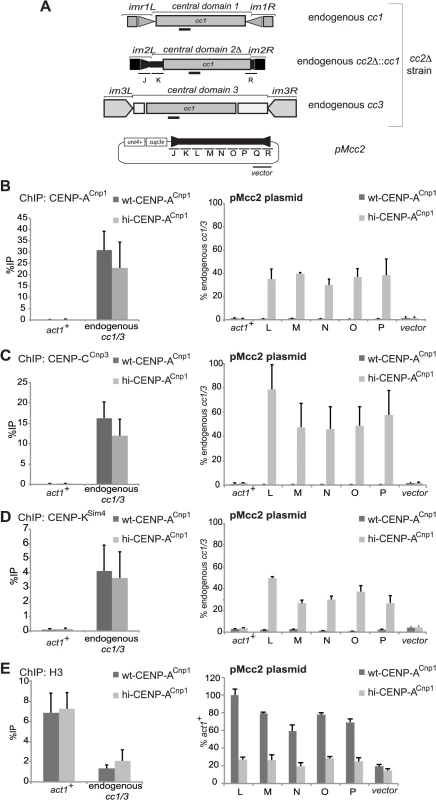
All strains used have 6 kb of cen2 central domain DNA replaced with 5.5 kb of cen1 central domain DNA (cc2Δ::cc1—Fig. 1A, S1 Fig.) so that only 2.5 kb of normal cen2 central domain DNA remains at this modified cen2 (imr2L, regions J, K, R; Fig. 1A). The resulting deletion of fragments L-Q from the cen2 central domain allows detailed and specific analysis of 6 kb of central domain DNA when borne by plasmid-based minichromosomes. Quantitative chromatin immunoprecipitation assays (qChIP) shows that CENP-ACnp1 chromatin does not assemble on regions L, M N, O or P when a plasmid (pMcc2) containing the 8.5 kb cc2 sequence, but lacking heterochromatin, was transformed into wild-type cells [45]. However, when pMcc2 was transformed into cells over-expressing CENP-ACnp1 (hi-CENP-ACnp1; ∼15 fold more than wild-type cells [41]), CENP-ACnp1 and the kinetochore proteins CENP-CCnp3 and CENP-KSim4 were easily detected over the central domain of pMcc2 by qChIP (Fig. 1B-E). Importantly, these centromeric proteins were enriched on centromeric DNA but not on the plasmid backbone, indicating that CENP-ACnp1 chromatin assembles specifically on central domain DNA from centromeres (Fig. 1). The relative level of enrichment of CENP-ACnp1 and the other kinetochore proteins on different parts of pMcc2 suggests all proteins are distributed uniformly across this plasmid-borne central domain (Fig. 1B-D). Furthermore, the levels of histone H3 associated with the L-P regions of pMcc2 were reduced in cells expressing additional CENP-ACnp1 compared to control cells (Fig. 1E). We conclude that H3 chromatin is normally assembled on central domain DNA on pMcc2 in wild-type cells but CENP-ACnp1 chromatin assembles instead when pMcc2 is placed in hi-CENP-ACnp1 cells.
CENP-ACnp1 can assemble on pre-chromatinised substrates and is trans-generationally inherited
To determine whether CENP-ACnp1 can become established on plasmids that are already assembled in chromatin, the pMcc2 plasmid was transformed into cells expressing wt-CENP-ACnp1 levels and subsequently crossed with hi-CENP-ACnp1 cells. qChIP analyses indicate that CENP-ACnp1 is initially absent from pMcc2 in the wt-CENP-ACnp1 parental strain and then becomes assembled in CENP-ACnp1 chromatin when transferred into the hi-CENP-ACnp1 environment, indicating that plasmid-borne cc2 initially assembled in normal (H3) chromatin can be converted to CENP-ACnp1 chromatin (Fig. 2A).
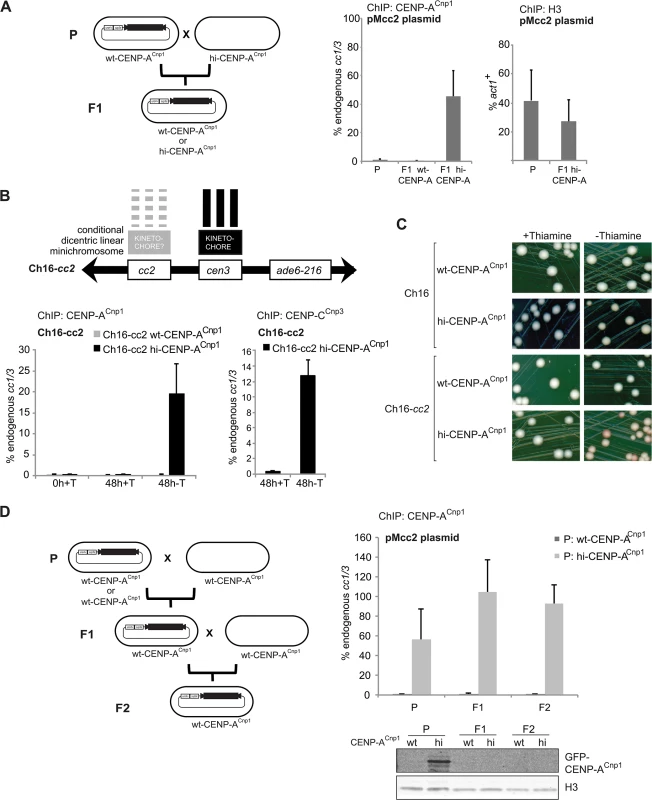
In addition, a copy of cc2 (8.5 kb) was inserted on the arm of the 530 kb Ch16 linear minichromosome which carries a complete cen3 [48] (Ch16-cc2; Fig. 2B). When the expression of additional GFP-CENP-ACnp1 was repressed (0h+T), no CENP-ACnp1 was detected on cc2. However, when GFP-CENP-ACnp1 was induced (48h-T) both CENP-ACnp1 and CENP-CCnp3 were detected on cc2 (Fig. 2B). Thus, cc2 borne on a linear minichromosome can be converted from a pre-chromatinised state to a CENP-ACnp1 state. Moreover, colony colour assays indicate that hi-CENP-ACnp1 expression induces increased loss of Ch16-cc2, which is consistent with a second functional kinetochore being formed at cc2 on Ch16 (Fig. 2C). Thus, Ch16-cc2 behaves as an inducible dicentric chromosome controlled by CENP-ACnp1 levels.
It is possible that high levels of CENP-ACnp1 are continuously required to maintain CENP-ACnp1 on pMcc2, or alternatively, once established, CENP-ACnp1 and kinetochore proteins may persist even when CENP-ACnp1 is returned to wild-type levels (wt-CENP-ACnp1). To investigate the maintenance of CENP-ACnp1 chromatin, pMcc2 was first transformed into hi-CENP-ACnp1 cells to allow the assembly of centromeric chromatin and subsequently these pMcc2-containing cells were crossed with wt-CENP-ACnp1 cells to transfer the pMcc2 plasmid into cells expressing wild-type CENP-ACnp1 levels. ChIP analyses show that CENP-ACnp1 persisted on the pMcc2 in this wild-type background (Fig. 2D). Western analysis of extracts from Parental, F1 and F2 cells confirmed that GFP-CENP-ACnp1 was lost in F1 and F2 cells (Fig. 2D). Thus, CENP-ACnp1 chromatin behaves as a true epigenetic entity in that once established it carries its own efficient propagation mechanism, persisting even though the original stimulus has been removed. More remarkably, this CENP-ACnp1 chromatin is maintained through 2 rounds of meiosis and at least 50 mitotic divisions. Thus central domain sequences are particularly receptive to the establishment and maintenance of CENP-ACnp1 chromatin.
Central domain sequence and length affect de novo CENP-ACnp1 deposition
To determine if specific regions from the central domain of cen2 are required to establish CENP-ACnp1 chromatin, plasmids bearing different sub-fragments from cc2 were transformed into wt-CENP-ACnp1 or hi-CENP-ACnp1 cells (Fig. 3). We used an unbiased approach to divide the 8.5 kb cc2 into 1 kb regions (J-R). Deletion of 1 kb from the centre of cc2 (N) does not affect CENP-ACnp1 establishment (pΔN; Fig. 3A, compare with pMcc2, Fig. 1B). Notably, CENP-ACnp1 incorporation on a plasmid carrying identical centromeric DNA as pΔN but with the right half (O-R) inverted relative to the native sequence, was less efficient (pΔN-rev; Fig. 3B). Thus, the relative orientation of central domain sequences within cc2 influences the degree of CENP-ACnp1 deposition; directionality or the juxtaposition of certain sequences may be important for promoting CENP-ACnp1 incorporation. The central CENP-ACnp1 domain at endogenous fission yeast centromeres is composed of inverted imr repeats that flank the central core. ChIP analyses demonstrated that, in a plasmid-based establishment assay, the imr repeats are dispensable for de novo CENP-ACnp1 incorporation on the remaining central domain sequences (pΔimr; Fig. 3C).
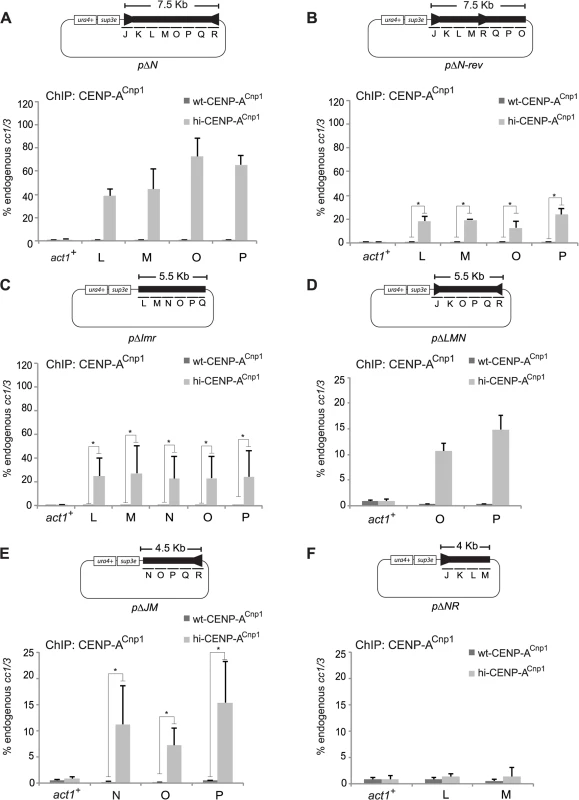
Deletion of additional regions (LMN) of cc2 markedly decreased the efficiency of CENP-ACnp1 incorporation relative to pMcc2 and pΔN (Fig. 3D; compare Fig. 1B, Fig. 3A), suggesting that either the LM region is critical for promoting CENP-ACnp1 incorporation or that the overall reduced centromeric DNA length diminishes CENP-ACnp1 deposition (Fig. 3D). However, further investigation using plasmids bearing smaller cc2 fragments suggests that the specific sequences present have a more significant influence on CENP-ACnp1 deposition than the overall length of cc2 DNA present (Fig. 3E,F). For example, pΔJM and pΔNR differ by only 500 bp, however, pΔJM incorporated substantially more CENP-ACnp1 than pΔNR (Fig. 3F). We conclude that specific sequences from the central domain of fission yeast centromeres, combined with their overall length, promote the efficient de novo assembly of CENP-ACnp1 chromatin.
A 2 kb region of centromeric DNA is sufficient to direct de novo CENP-ACnp1 chromatin assembly
It is possible that shorter fragments of centromere DNA from within the central domain can actively promote CENP-ACnp1 assembly but that because longer total lengths are required to stabilise incorporated CENP-ACnp1 the activity of shorter fragments cannot be detected. To address this possibility we selected two distinct sequences from the central domain of cen2 for analyses. The 2 kb OP region was present on all the pMcc2 derivatives with which we detected significant CENP-ACnp1 incorporation following transformation into hi-CENP-ACnp1 cells (Fig. 3). In addition, ChIP-seq analysis indicates particularly high CENP-ACnp1 nucleosome occupancy within OP at endogenous cen2 [49 and Fig. 4A]. In contrast, the 2 kb LM region appears to be dispensable for de novo CENP-ACnp1 assembly on pMcc2 derived plasmids and exhibits low CENP-ACnp1 nucleosome occupancy (Fig. 3, Fig. 4A).
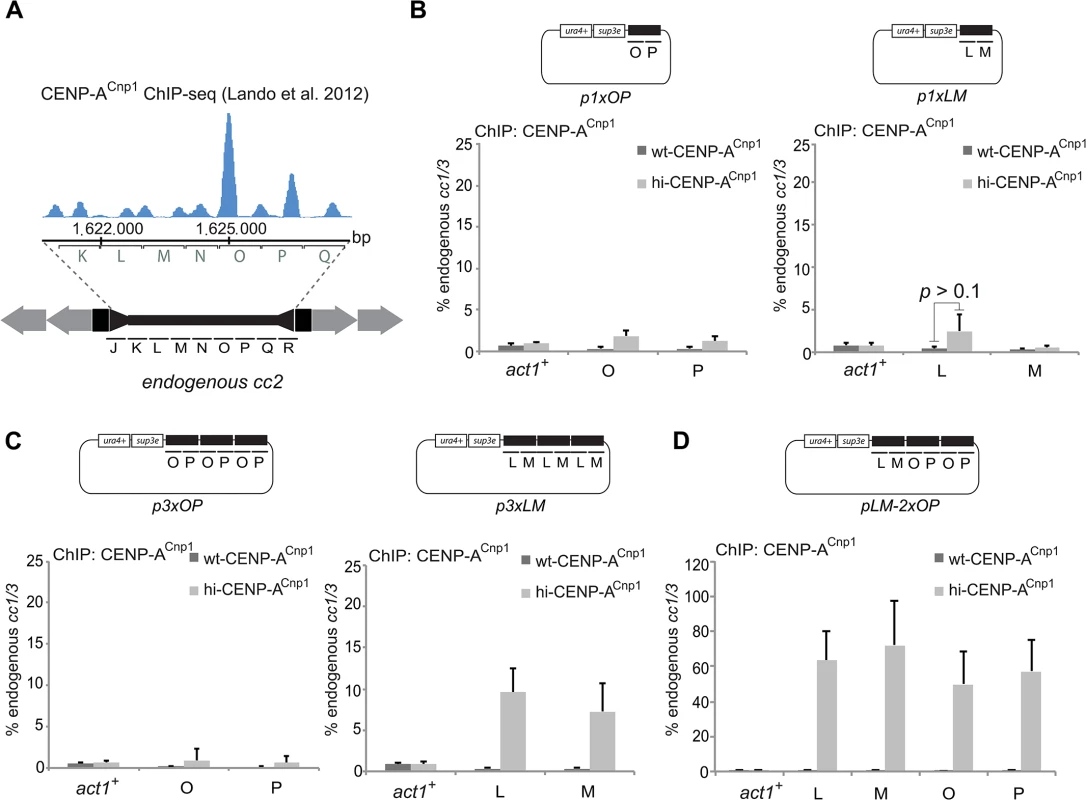
Initial tests showed that neither OP (p1xOP) nor LM (p1xLM) sequences alone were capable of inducing significant de novo CENP-ACnp1 incorporation when introduced into hi-CENP-ACnp1 cells (Fig. 4B). This finding is consistent with a minimal length of central domain DNA being required for stable CENP-ACnp1 chromatin assembly and retention. To satisfy this apparent length requirement, the OP and the LM fragments were multimerised as tandem repeats to create 3xOP and 3xLM (p3xOP, p3xLM; Fig. 4C). Remarkably, when transformed into hi-CENP-ACnp1 cells no CENP-ACnp1 was detectable on p3xOP whereas p3xLM allowed a reasonable level of CENP-ACnp1 incorporation (Fig. 4C). This suggests that in isolation the OP region is unable to promote CENP-ACnp1 deposition even though in the context of an entire central domain it normally accepts CENP-ACnp1 and ends up with high CENP-ACnp1 nucleosome occupancy (Fig. 4A). We note that the removal of the LM region from the central domain of pMcc2 derived plasmids greatly reduced the level of CENP-ACnp1 incorporated on OP (compare pΔN Fig. 3A with pΔLMN Fig. 3D). Thus, in contrast to OP, the LM region appears to have the ability to induce CENP-ACnp1 deposition. To directly test this possibility, a single copy of LM was placed adjacent to two tandem copies of OP (pLM-2xOP) and transformed into hi-CENP-ACnp1 cells. High levels of CENP-ACnp1 were detected on both the LM and OP regions of pLM-2xOP (Fig. 4D), thus the LM region has an innate ability to stimulate CENP-ACnp1 deposition on the OP region. A different arrangement of the same sequences (pOPLMOP) also attracted CENP-ACnp1 in hi-CENP-ACnp1 cells (S2 Fig.). These analyses indicate that the 2 kb LM sequence contains all the features that are required to promote and accept CENP-ACnp1 assembly, and thus LM defines a 2 kb region of S. pombe centromeric sequence that allows the de novo assembly of CENP-ACnp1 chromatin.
The 2 kb LM element is sufficient to form functional centromeres
Plasmids bearing an entire central core domain flanked by outer heterochromatin repeats assemble functional centromeres when transformed into wild-type cells [45,50]. To determine if the 2 kb LM region imparts centromere function, a plasmid carrying the 3xLM tandem repeat adjacent to a 5 kb outer repeat heterochromatin forming element (pH-3xLM) was transformed into wild-type cells expressing CENP-ACnp1 at normal levels (Fig. 5A). The establishment of functional centromeres in the resulting transformants was monitored by an ade6-based colony colour sectoring assay [51]. Minichromosomes carrying full-length cc2 and 5 kb of outer repeat heterochromatin were able to establish functional centromeres upon transformation (Fig. 5B and S2 Fig.). pH-3xLM and pH-LM-2xOP transformants also established functional centromeres, but at lower frequency than pH-cc2 (Fig. 5B and S2 Fig.). Differences in the ability of various constructs to form functional centromeres may reflect the particular configuration of sequences in individual minichromosomes. In contrast, pH-3xOP (3xOP flanked by heterochromatin) was unable to establish functional centromeres. Thus the LM sequence in a 3x tandem array, flanked by heterochromatin, is sufficient to form functional centromeres. ChIP analyses confirmed that kinetochores were assembled on pH-3xLM since CENP-ACnp1 and the kinetochore proteins CENP-CCnp3 and CENP-KSim4 were enriched over the LM sequences at levels comparable to endogenous centromeres (Fig. 5C). We conclude that the LM sequence within pH-3xLM not only promotes incorporation of CENP-ACnp1 into chromatin but also supports the assembly of a functional centromere.
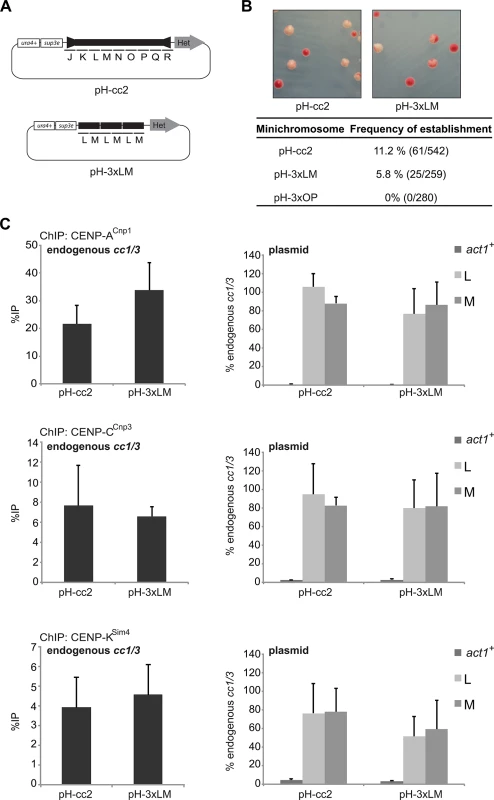
Features within centromeric central domain DNA are required to promote CENP-ACnp1 chromatin establishment
Nucleosome occupancy is known to be influenced by a combination of DNA sequence and the action of chromatin remodelers [52]. Primary DNA sequence itself influences nucleosome occupancy since DNA sequences with a high GC content and periodic dinucleotide patterns, that are devoid of poly(dA:dT) sequences, are strongly favored for nucleosome occupancy because of biophysical constraints that allow such sequences to wrap more easily around nucleosomes. These constraints have led to the development of algorithms that predict the probability of nucleosome occupancy [53,54]. In common with centromeres of many organisms, fission yeast centromeric DNA is AT-rich with a higher frequency of poly(dA:dT) tracts. It is therefore possible that H3 nucleosomes have a lower affinity for such sequences whereas CENP-A nucleosomes may be unperturbed by such AT rich DNA. To examine the underlying sequence specificity within centromeric DNA that favours the deposition of CENP-ACnp1 nucleosomes, the sequence of LM DNA was altered by randomisation using a 5 bp sliding window throughout the entire 2 kb element. This generated a synthetic LM sequence (SynR-LM) that is 62.6% identical to the wild-type LM sequence, retaining the same AT content and dinucleotide periodicity, and thus the same predicted nucleosome occupancy as the wild-type LM element (Fig. 6A) [55].
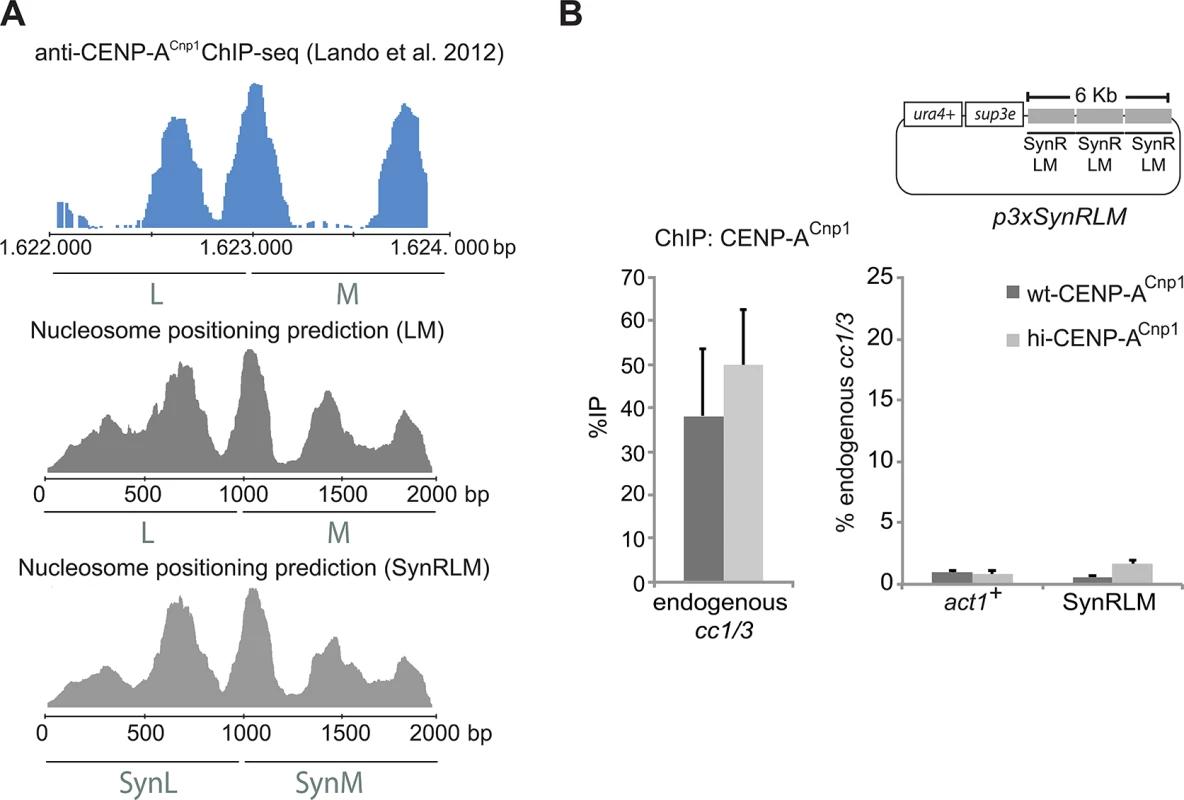
Synthesised SynR-LM assembled as a 3xSynR-LM tandem array was placed in the same plasmid backbone as p3xLM to generate p3xSynR-LM. p3xSynR-LM was transformed into wt-CENP-ACnp1 and hi-CENP-ACnp1 cells. In contrast to p3xLM, CENP-ACnp1 was not detectable on the shuffled LM sequence of pSynR-LM (Fig. 6B, compare with Fig. 4B). These analyses demonstrate that preservation of nucleotide composition (AT-content, dinucleotide periodicity) and predicted nucleosome occupancy within an altered centromeric DNA is not sufficient to allow CENP-ACnp1 deposition. The fact that the natural 2 kb LM sequence is active whereas the artificial SynR-LM is inactive reveals that the primary sequence of wild-type centromeric LM DNA encodes properties that somehow allow its recognition in vivo and consequent de novo assembly of CENP-ACnp1 chromatin.
Centromeric DNA produces an unusual transcriptional environment
Upon transformation into cells innate features within 3xLM sequence must allow it to be either immediately assembled in CENP-ACnp1 chromatin, or, initially assembled in H3 chromatin with subsequent remodelling that exchanges canonical H3 for CENP-ACnp1. The process of transcription is obviously accompanied by chromatin remodelling and non-coding transcripts synthesised from within the central CENP-ACnp1 domains of fission yeast centromeres have been detected [37,42]. The transcription of central domain DNA might influence the assembly of CENP-ACnp1 chromatin. In cells expressing CENP-ACnp1 at wild-type levels, plasmid-borne central domain sequences are assembled in H3 rather than CENP-ACnp1 chromatin (Fig. 1E). Higher levels of RNAPII are detected on plasmid-borne central domain sequences (pMcc2) introduced into wild-type cells than when cc2 is assembled in CENP-ACnp1 chromatin on pMcc2 or at endogenous centromeres (Fig. 7A, S3 Fig.). Although relatively high levels of RNAPII associate with the pMcc2 central domain when assembled as H3 chromatin in wild-type cells (10–30% of levels at act1+) (Fig. 1E, Fig. 7A), the level of transcripts emanating from the central domain is very low (<0.1% of act1+), even when analysed in exosome defective cells (dis3–54; Fig. 7B). Thus, although ample RNAPII is recruited to the central domain of pMcc2 few transcripts are generated, suggesting that transcriptional stalling occurs.
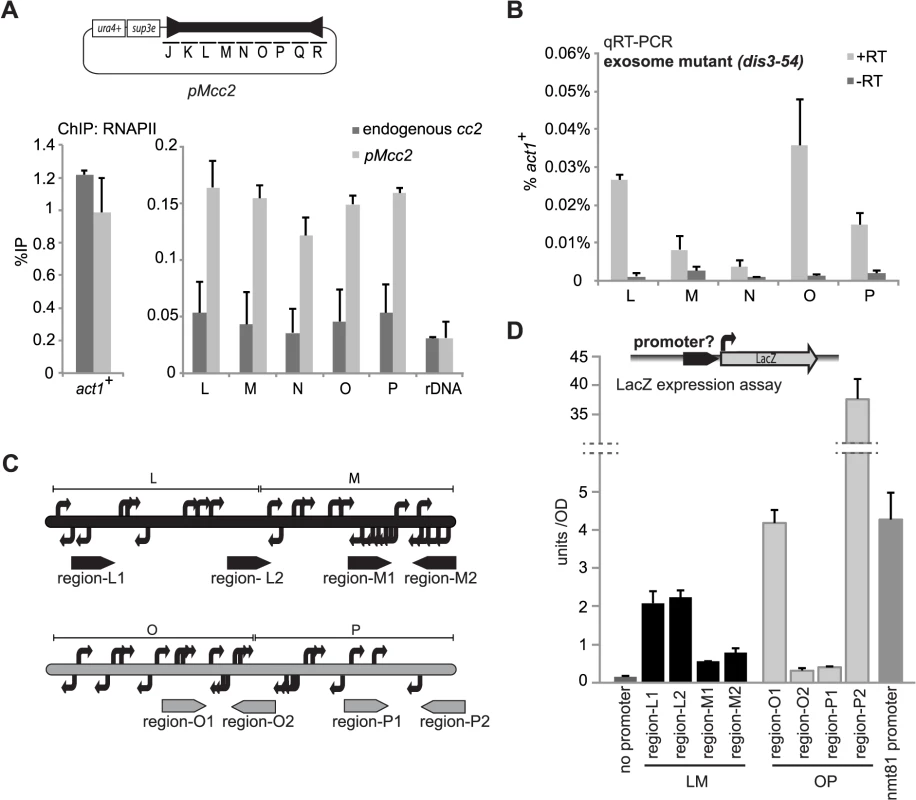
To map transcriptional start sites (TSSs) within the LM and OP regions, 5’ RACE was performed on RNA extracted from dis3–54 exosome mutant cells harbouring p3xLM or p3xOP (Fig. 7C, S4 Fig.). Many TSSs were identified within LM and OP, suggesting that these regions contain several promoters (Fig. 7C). 200 bp regions from both LM and OP were tested for their ability to drive production of β-galactosidase when placed upstream of a lacZ reporter in fission yeast and as shown in Fig. 7D, the regions displayed promoter activity. Mutated or inverted versions of promoter region M2 did not promote transcription of LacZ (S4 Fig.). Whilst most regions of LM and OP exhibit promoter activity that is lower than that of nmt81 control promoter, it is notable that region-O1 and region-P2 from OP have equivalent and 10-fold higher activity, respectively (Fig. 7D). It is possible that the higher promoter activity possessed by some regions of OP may affect its ability to establish CENP-ACnp1. We surmise that the central domain from cen2 is peppered with promoters that can drive the production of transcripts on both strands. Their relative arrangement along with the strength and pattern of transcription may affect CENP-ACnp1 incorporation.
CENP-ACnp1 establishment is enhanced in mutants that increase RNAPII stalling
The progression of RNAPII is impeded by obstacles such as nucleosomes, DNA damage, bound proteins and by sequences that are intrinsically difficult to transcribe, causing transcriptional pausing, stalling or arrest [56]. RNAPII-associated proteins ease the passage of RNAPII through such impediments, contributing to the processivity of the polymerase [57]. TFIIS facilitates transcriptional elongation of stalled/backtracked RNAPII by stimulating cleavage of nascent transcripts [58–60]. Upon stalling an elongating RNAPII becomes mono- then poly-ubiquitylated on the largest Rpb1 subunit. A rescue pathway involving de-ubiquitylation by the ubiquitin hydrolase Ubp3 is deployed to restart stalled RNAPII [56,61].
Our analyses suggest that the central domain chromatin landscape contains numerous promoters on both strands and multiple TSSs. In addition, long poly(dA:dT) tracts are likely to be an intrinsically problematic sequence for RNAPII transcription and present a barrier to RNAPII elongation [62,63]. We reasoned that mutants that are defective in the response to transcriptional stalling might influence the ability of the central domain to become assembled in CENP-ACnp1 chromatin. To test this possibility, wild-type and TFIIS (tfs1Δ) mutant cells expressing hi-CENP-ACnp1 were transformed with pMcc2. Surprisingly, slightly increased levels of CENP-ACnp1 were detected on pMcc2 in the tfs1Δ mutant compared to wild-type cells, suggesting that loss of TFSII promotes CENP-ACnp1 deposition (S5 Fig.). Consistent with this, even when pMcc2 was transformed into tfs1Δ cells expressing wt-CENP-ACnp1 levels, CENP-ACnp1 was detected on the pMcc2 central domain (Fig. 8A). In order to determine whether the effect on CENP-ACnp1 establishment was specific to tfs1Δ or a general consequence of increased RNAPII stalling, we also investigated if loss of the ubiquitin hydrolase Ubp3, which normally rescues arrested RNAPII, affects CENP-ACnp1 deposition. Strikingly, CENP-ACnp1 was detected at high levels on central domain sequences in ubp3Δ cells transformed with pMcc2. CENP-ACnp1 was also detected on p3xLM, but not p3xOP in ubp3Δ (Fig. 8B, S6 Fig.). CENP-CCnp3 and CENP-KSim4 centromere proteins were also significantly enriched on pMcc2 in ubp3Δ cells (S8 Fig.). These effects were not due to increased abundance of CENP-ACnp1 in tfs1Δ or ubp3Δ cells as protein levels were similar to wild-type cells (S7 Fig.). In fact, a reduction in CENP-ACnp1 and CENP-CCnp3 levels was detected at endogenous centromeres in ubp3Δ, but not tfs1Δ cells (S8 Fig.). Tfs1 and Ubp3 were previously reported to modulate RNAi-independent heterochromatin assembly [64]. To test whether the effect on CENP-ACnp1 establishment in tfs1Δ or ubp3Δ cells could be due to spurious assembly of heterochromatin on pMcc2, H3K9me2 ChIP was performed. The level of H3K9me2 on pMcc2 in tfs1Δand ubp3Δ was similar to that on a negative control locus, act1+, and assembly of CENP-ACnp1 on pMcc2 in these mutants was not dependent on the H3K9-methyltransferase Clr4 (S9 Fig.). Thus, CENP-ACnp1 assembly on pMcc2 in the absence of TFIIS or Ubp3 does not result from induction by ectopic heterochromatin.
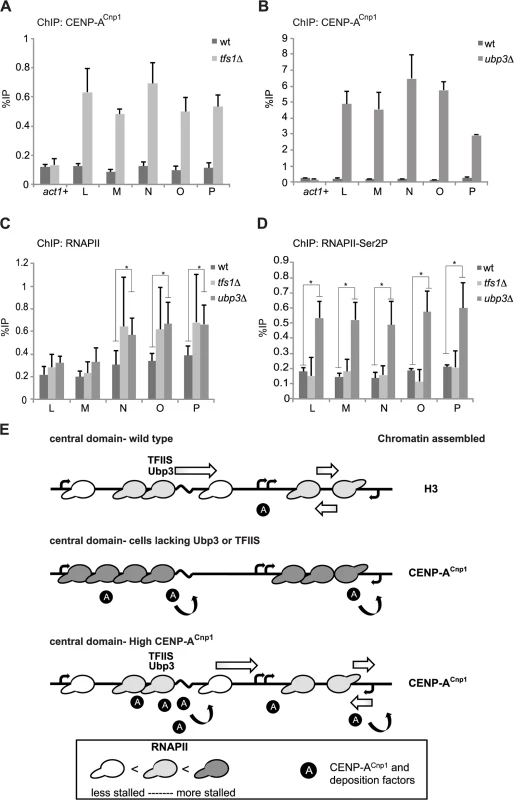
If lack of TFIIS or Ubp3 hinders transcriptional elongation, an increased level of RNAPII would be expected on affected chromatin templates. Elevated levels of Rpb1/RNAPII were detected on the central domain of pMcc2 in tfs1Δ (TFIIS) and ubp3Δ cells (Fig. 8C). In addition, increased levels of the elongation-specific Phospho-Ser2 form of RNAPII were observed on the central domain of pMcc2 in ubp3Δ cells, suggestive of failure to efficiently clear stalled RNAPII (Fig. 8D). Thus, two mutants, which perturb the progress of RNAPII elongation complexes in different ways, lead to deposition of CENP-ACnp1. These observations suggest that altering the transcriptional properties of the central domain chromatin through increased RNAPII stalling creates an environment that is permissive for establishment of CENP-ACnp1 chromatin in place of H3 chromatin.
Discussion
It is thought that once established, CENP-A chromatin has the ability to be ‘self-propagating’, and through the recruitment of factors that are themselves involved in deposition of CENP-A, it ensures its own maintenance [16,17,23,24,26,65]. Epigenetic inheritance can be defined as the propagation of a state in the absence of the initial inducer of that state. In this study, the inducer—overexpression of CENP-ACnp1—causes an event that would not normally occur, the assembly of CENP-ACnp1 chromatin on episomal centromeric DNA (pMcc2). When CENP-ACnp1-assembled pMcc2 is crossed from hi-CENP-ACnp1 cells into wt-CENP-ACnp1 cells, CENP-ACnp1 is propagated in the absence of the initial inducer through many generations and through meiosis. These observations further strengthen the evidence that CENP-A behaves as a bona fide epigenetic entity [24].
It is clear that both epigenetic and genetic factors influence CENP-A assembly. We have investigated the role of DNA sequence in establishment of CENP-A chromatin in fission yeast, an organism where analysis is not confounded by repetitive arrays of short satellite sequences. CENP-ACnp1 is normally restricted to the central domain of centromeres where it forms the basis for the kinetochore. Central domain DNA is a preferred substrate for establishment of CENP-ACnp1 chromatin upon overexpression, whilst other genomic loci do not support accumulation of high levels of CENP-ACnp1 [47], and even vector DNA adjacent to the central domain is not a good substrate. Conditions and mechanisms that influence assembly of CENP-ACnp1 on naïve plasmid DNA are also able to convert pre-chromatinised cc2 present on episomal plasmids or linear minichromosomes. What makes central domain DNA a preferred site for CENP-ACnp1 assembly? The lack of homology between cc2 and cc1/cc3 sequences suggests that it is not a simple case of specific sequence that is critical [66–68]. Our analyses indicate that there is functional redundancy within the central domain and no one particular sequence is either necessary or sufficient for CENP-ACnp1 establishment, consistent with previous findings [50]. Despite this redundancy it appears that there are inherent distinctions between different regions of cc2. The 2 kb sub-regions, LM and OP, are functionally non-equivalent and consistently behaved differently when challenged to assemble CENP-ACnp1 chromatin. LM is competent to establish centromeric chromatin upon CENP-ACnp1 overexpression, contains sufficient information to make a functional centromere when placed next to heterochromatin (pH-3xLM), and assembles CENP-ACnp1 chromatin in cells lacking Ubp3. On the other hand, the OP region fails to become assembled in CENP-ACnp1 chromatin in all these situations, yet can accept CENP-ACnp1 when adjacent to one copy of LM, which apparently acts as an initiator. The ability of LM, but not OP, to substitute for full-length cc2 sequence indicates that not all sequences are equivalent and LM must contain all information necessary to make this region permissive for CENP-ACnp1 establishment. It is possible that the observed higher promoter activity observed in the OP region (Fig. 7D) prevents stabilisation of CENP-ACnp1 nucleosomes on this sequence.
In common with many organisms, the central domain of S. pombe centromeres is AT rich and this property might contribute to the propensity of centromeric DNA to attract CENP-A [5,68]. S. pombe central domain DNA has an AT content of 72% (genome average of 64%), as does the establishment competent LM sequence. However, other regions that alone fail to support CENP-ACnp1 establishment have a similar AT content, such as OP (71% AT) and intergenic regions (72% AT). Moreover, randomisation of the LM sequence resulted in SynR-LM that, even with identical nucleotide composition (72% AT), was incompetent for CENP-ACnp1 establishment. Thus, high AT content alone, even when it mimics natural nucleosome positioning predictions, is not a defining factor in CENP-ACnp1 assembly. Together our observations indicate that rather than there being a specific critical sequence, central domain sequences encode unique properties capable of triggering or promoting the establishment of CENP-ACnp1 chromatin.
Transcription-coupled remodelling is associated with the deposition of histone variants and could potentially contribute to the assembly of CENP-A chromatin [69,70]. However, the simple act of transcription cannot be sufficient to provide specificity to the deposition of CENP-A. Our observations suggest that the transcriptional landscape of the centromeric central domain is unusual: scattered promoters of various strengths resulting in pervasive low quality transcription and numerous TSSs on both strands, in conjunction with poly(dA:dT) tracts that are inherently difficult to transcribe are likely to cause collision between convergently transcribing RNAPIIs and pile-ups at difficult sequences [63,71]. The relatively high density of RNAPII on pMcc2 contrasts with very low levels of transcripts (Fig. 7), consistent with inefficient progress of transcription by RNAPII on cc2, and many stalled elongation complexes. In addition, long tracts of poly(dA:dT) are known to disfavour nucleosome assembly, consistent with the apparently wide spacing of nucleosomes at endogenous centromeres [49,72]. These regions may be de facto nucleosome free regions, similar to those at promoters, allowing cryptic initiation of transcription to occur [72,73]. The randomized synthetic sequence SynR-LM that is a poor substrate for CENP-ACnp1 deposition has similar long A tracts, but transcription-related sequence-sensitive elements—such as promoters and transcription factor binding sites—would be destroyed. Thus, the central domain, due to its sequence-encoded properties, may produce a distinctive chromatin and transcriptional environment.
CENP-ACnp1 chromatin does not assemble de novo on cc2 sequence alone in wild-type cells expressing normal CENP-ACnp1 levels [45]. Instead, we envisage that the unique transcriptional chromatin environment created by the cc2 sequence renders it permissive for CENP-ACnp1 establishment, but that establishment occurs only if other favourable conditions exist. CENP-ACnp1 is preferentially incorporated on these central domain sequences upon overexpression, when adjacent to heterochromatin, and in the absence of factors that usually enhance transcriptional elongation. Any explanation of CENP-ACnp1 chromatin establishment on central domain DNA must also account for how CENP-ACnp1 is incorporated instead of H3. Serine 2 in the CTD heptad repeat of Rpb1 is phosphorylated in elongating RNAPII, and this Ser2P-Rbp1/RNAPII becomes ubiquitylated upon stalling [74–76]. The ubiquitin hydrolase Ubp3 normally acts as a proof-reading activity to prevent degradation of stalled but rescuable RNAPII [56,61]. Absence of Ubp3 compromises the processing of stalled RNAPII, resulting in the accumulation of ubiquitylated Ser2P-Rbp1/RNAPII complexes. We propose that such modifications contribute to the distinctive status of central domain chromatin, leading to recruitment of factors that promote CENP-ACnp1 deposition (Fig. 8E). Alternatively, it may create an environment in which H3 nucleosomes are efficiently turned over/evicted, whereas CENP-ACnp1 nucleosomes are poorly evicted specifically in the context of stalled RNAPII. In cells lacking Ubp3, severe or prolonged stalling, even with normal levels of CENP-ACnp1, would provide extended opportunities for CENP-ACnp1 recruitment, or poor eviction of CENP-ACnp1 during prolonged stalling. TFIIS promotes transcriptional elongation by cleaving nascent transcripts in the context of stalled/backtracked RNAPII [57,58,77]. Although the effects of TFIIS deletion are more subtle than lack of Ubp3, the accumulation of RNAPII correlates with assembly CENP-ACnp1 chromatin, supporting a mechanism where persistent RNAPII stalling within central domain triggers remodelling that results in CENP-ACnp1 deposition.
In this model, when naïve central domain DNA (pMcc2) is introduced into wild-type cells, transient stalling occurs but it is efficiently cleared with the aid of factors such as TFIIS and Ubp3 (Fig. 8E). Because in wild-type cells CENP-ACnp1 levels are extremely low compared to histone H3 there would be little opportunity for CENP-ACnp1 to gain access to cc2, and with efficient clearing of stalled RNAPII, CENP-ACnp1 would fail to accumulate in cc2 [78]. CENP-ACnp1 overexpression would increase the probability of interaction with the transiently stalled RNAPII in central domain chromatin, increasing the likelihood of recruitment. Alternatively, increased access coupled with poor eviction would lead to CENP-ACnp1 accumulation. In addition, CENP-ACnp1 nucleosomes themselves, which have distinct N-terminal tails that lack the conserved lysine residues of H3 whose modification aids transcription, are likely to present a greater barrier to transcription than H3 nucleosomes [79]. Thus, once incorporated, CENP-ACnp1 nucleosomes might exacerbate the poor transcriptional elongation, creating conditions permissive for recruitment of more CENP-ACnp1 in a self-perpetuating system. Longer regions of central domain DNA would have greater probability of triggering stalling events and thus be more likely to initiate the incorporation of CENP-ACnp1. In the context of this model, heterochromatin could promote establishment of CENP-ACnp1 chromatin on adjacent cc2 sequence by drawing plasmids to sites of endogenous heterochromatin such as the spindle pole body where they would encounter a higher concentration of CENP-ACnp1 than non-heterochromatinized plasmids located in the nuclear interior [80]. Alternatively, heterochromatin-associated chromatin modifying activities may influence transcriptional elongation by RNAPII within cc2, causing enhanced stalling and deposition of CENP-ACnp1[41].
Following establishment of CENP-A chromatin and kinetochore assembly, transcription could play a proof-reading role that evicts H3 deposited at centromeres during S phase [81]. Indeed, transcription and RNAPII have been detected at centromeres in mammalian cells and transcription/RNAPII may play a role in centromere integrity [33,34,38]. Transcription of human α-satellite arrays introduced as HACs is known to occur. Although CENP-A assembly is compatible with targeting of mild transcriptional activators, targeting of a strong transcriptional activator is deleterious [30,38,82]. Thus transcription and/or the transcription-coupled histone modifications detected at centromeres may promote CENP-A deposition at mammalian centromeres.
In conclusion, we show that the sequence of fission yeast centromere central domain DNA is important only in so far as it encodes for certain properties that contribute to the region’s unusual chromatin and transcriptional landscape. Establishment of CENP-ACnp1 chromatin is driven by these sequence-encoded properties that when combined with the presence of nearby heterochromatin, overexpressed CENP-ACnp1 or increased RNAPII stalling, tips the balance in favour CENP-ACnp1 chromatin assembly. It seems likely that a similar combination of factors, which together favour CENP-A incorporation, must also contribute to the formation of neocentromeres at novel chromosomal locations.
Materials and Methods
Cell growth and manipulation
Standard genetic and molecular techniques were followed. Fission yeast methods were as described [83]. Fission yeast strains are listed in Table 1. Minichromosomes used in this study were transformed by electroporation. Transformants were selected by growth on PMG—ura—ade at 32°C. As circular minichromosomes lack heterochromatin and therefore centromeric cohesion, plasmids were maintained in cells by selection in medium lacking adenine and uracil. 3 independent colonies from each transformation were analysed for the presence of kinetochore proteins by chromatin immunoprecipitation (ChIP).
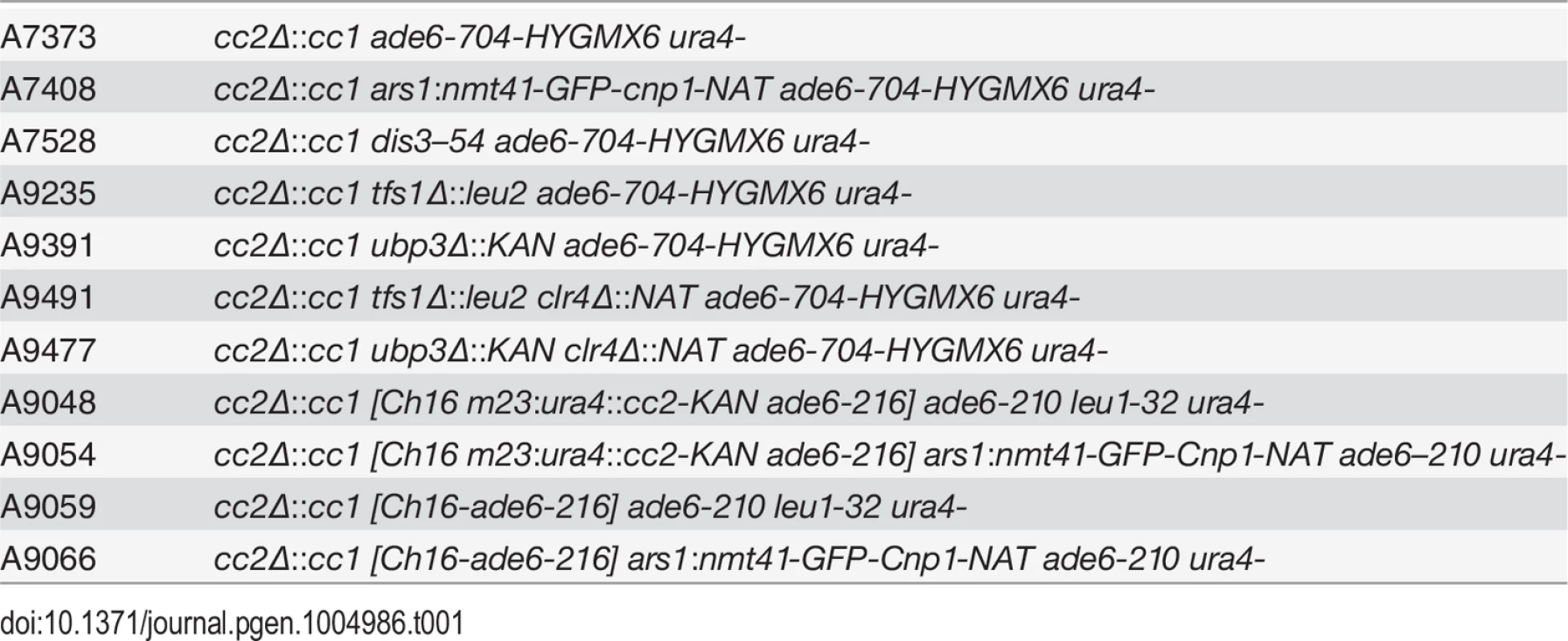
Centromere plasmids and minichromosomes
Plasmids bearing centromere fragments contained a minimal ars1 element to ensure efficient replication in S. pombe, in addition to selectable markers sup3-5 (complements ade6-704), ura4+ and KANR. 8.5 kb of central domain DNA (cc2 plus inner part of imr2L and imr2R) was cloned into the multiple cloning site as a SalI-NcoI fragment to create pMcc2. Various sub-fragments of cc2 (J-Q) were amplified by PCR and cloned into the multiple cloning site as BamHI/BglII fragments. 5.6 kb of heterochromatin-forming outer repeat sequence was inserted adjacent to central domain sequences to test ability to form functional centromeres.
A plasmid, pMC28, bearing cc2, a KAN resistance marker and an inverted ura4 sequence was constructed from pMcc2. Linearisation of the plasmid at NotI within the inverted ura4 sequence allowed integration at ura4+ located on the arm of Ch16-m23:ura4+. Ch16-m23: ura4+ is a derivative of Ch16, a 530 kb minichromosome, itself derived from Chromosome III [48]. It also bears the ade6-216 allele which complements the ade6-210 allele present on endogenous Chromosome III by interallelic complementation. Integration of linearised pMC28 on Ch16-m23:ura4 allowed selection on the counter-selective drug 5-fluoro-orotic acid and G418 (KAN). Cells that lost the Ch16-m23:ura4::cc2-KAN (abbreviated as Ch16-cc2) became red on limiting adenine and were sensitive to G418. For growth in liquid, cells containing Ch16-cc2 were grown in media lacking adenine.
ChIP
ChIP was performed as previously described [84] using anti-CENP-Acnp1 antibody, anti CENP-CCnp3 antibody, anti-CENP-KSim4 antibody, anti-H3 antibody (ab1791; Abcam,), anti-H3K9me2 antibody (T. Urano) and anti-total RNA polymerase II (4F8; 61081, Active Motif), anti-Rpb1-Ser2P (3E10; 61083, Active Motif) and analysed by qPCR. Primers are listed in Table 2. P-values were calculated by standard t-test on 3 replicates between wild-type and mutant; p<0.05 was considered significant.

Establishment assay
For the establishment assay, cells were transformed with minichromosomes (containing 5.6 kb of outer repeat sequence in addition to cc2 sequences), by electroporation with ∼200 ng of DNA and plated on selective medium. Resultant colonies were replicated onto rich medium containing limiting adenine. The presence of pale pink/white colonies indicates establishment of a functional centromere on the minichromosome. Establishment efficiency is calculated as percentage of these colonies divided by the total number of transformants. Colonies were streaked on limiting adenine plates to confirm the presence of sectoring that is indicative of centromere function.
Real-time PCR (qPCR)
Quantitative PCR reactions were carried out in 10 μl volume, with 5μl Light Cycler 480 SybrGreen Master Mix (Roche), 0.5μl each primer (10 μM) and 3μl ChIP or total template. The data were analysed using Light Cycler 480 Software 1.5 (Roche).
5’RACE-PCR and RT-PCR
5’RACE-PCR was performed as previously described [37]. In brief, RNA was isolated with RNeasy mini/midi kit (Qiagen) according to the manufacturer’s protocol. Poly(A) containing RNA was purified from 500 μg of total RNA by affinity purification with biotinylated oligo-dT using PolyATtract mRNA Isolation Systems (Promega). 5’RACE PCR was performed using SMARTer 5’/3’ RACE (Clontech) according to the manufacturer’s protocol. PCR products were then run on 1% agarose gel, purified and cloned into pGEM-T Easy vector (Promega) and subsequently sequenced. Reverse transcription reaction for 5’RACE and qRT-PCR was performed using Superscript III Reverse Transcriptase (Invitrogen) using RNA extracted from 3 independent colonies. For qRT-PCR, transcript levels were normalized over gDNA to take into account differences in copy number between plasmids and normalized relative to act1+.
LacZ assay
LacZ assay was performed as described [85]. pREP81X-LacZ was digested with XhoI and PstI and the nmt81 promoter upstream of LacZ replaced with sequences from centromere 2. Plasmids were transformed into wild-type and grown on minimal medium (n = 3).
Southern analysis
DNA was extracted as previously described [83]. The DNA was digested with BglII/SpeI or SphI/SpeI, run on a 1% agarose gel, blotted on nylon membrane (Hybond N, Amersham) and UV-crosslinked. The membrane was hybridized with DNA probes specific for central domain 1 or central domain 2. To make the probes, PCR products were used as template in the labelling reaction using High Prime (Roche). Primers sequences are listed in Table 2.
Western analysis
Western analysis was performed as described previously using anti-GFP antibody (Roche) and anti-H3 antibody (ab1794-abcam) [86]. The intensities of GFP and H3 signals were acquired using LICOR Odyssey Infrared Imaging System software (Li-COR Bioscience).
Supporting Information
Zdroje
1. Westermann S, Schleiffer A (2013) Family matters: structural and functional conservation of centromere-associated proteins from yeast to humans. Trends in Cell Biology 23: 260–269. doi: 10.1016/j.tcb.2013.01.010 23481674
2. Henikoff S, Ahmad K, Malik HS (2001) The centromere paradox: stable inheritance with rapidly evolving DNA. Science 293: 1098–1102. 11498581
3. Meraldi P, McAinsh AD, Rheinbay E, Sorger PK (2006) Phylogenetic and structural analysis of centromeric DNA and kinetochore proteins. Genome Biol 7: R23. 16563186
4. Buscaino A, Allshire R, Pidoux AL (2010) Building centromeres: home sweet home or a nomadic existence? Current Opinion in Genetics & Development: 1–9.
5. Melters DP, Bradnam KR, Young HA, Telis N, May MR, et al. (2013) Comparative analysis of tandem repeats from hundreds of species reveals unique insights into centromere evolution. Genome Biol 14: R10. doi: 10.1186/gb-2013-14-1-r10 23363705
6. Biggins S (2013) The composition, functions, and regulation of the budding yeast kinetochore. Genetics 194: 817–846. doi: 10.1534/genetics.112.145276 23908374
7. Steiner FA, Henikoff S (2014) Holocentromeres are dispersed point centromeres localized at transcription factor hotspots. eLife Sciences 3: e02025. doi: 10.7554/eLife.02025 24714495
8. Maddox PS, Oegema K, Desai A, Cheeseman IM (2004) “Holo”er than thou: chromosome segregation and kinetochore function in C. elegans. Chromosome Res 12: 641–653. 15289669
9. Willard HF (1985) Chromosome-specific organization of human alpha satellite DNA. Am J Hum Genet 37: 524–532. 2988334
10. Willard HF (1989) The genomics of long tandem arrays of satellite DNA in the human genome. Genome 31: 737–744. 2698839
11. Marçais B, Laurent AM, Charlieu JP, Roizès G (1993) Organization of the variant domains of alpha satellite DNA on human chromosome 21. J Mol Evol 37: 171–178. 8411206
12. Pidoux AL, Allshire RC (2004) Kinetochore and heterochromatin domains of the fission yeast centromere. Chromosome Res 12: 521–534. 15289660
13. Sanyal K, Baum M, Carbon J (2004) Centromeric DNA sequences in the pathogenic yeast Candida albicans are all different and unique. Proc Natl Acad Sci USA 101: 11374–11379. 15272074
14. Shang WH, Hori T, Toyoda A, Kato J, Popendorf K, et al. (2010) Chickens possess centromeres with both extended tandem repeats and short non-tandem-repetitive sequences. Genome Research 20: 1219–1228. doi: 10.1101/gr.106245.110 20534883
15. Gong Z, Wu Y, Koblízková A, Torres GA, Wang K, et al. (2012) Repeatless and repeat-based centromeres in potato: implications for centromere evolution. Plant Cell 24: 3559–3574. doi: 10.1105/tpc.112.100511 22968715
16. Allshire RC, Karpen GH (2008) Epigenetic regulation of centromeric chromatin: old dogs, new tricks? Nat Rev Genet 9: 923–937. doi: 10.1038/nrg2466 19002142
17. Burrack LS, Berman J (2012) Neocentromeres and epigenetically inherited features of centromeres. Chromosome Res 20: 607–619. doi: 10.1007/s10577-012-9296-x 22723125
18. Marshall OJ, Chueh AC, Wong LH, Choo KHA (2008) Neocentromeres: new insights into centromere structure, disease development, and karyotype evolution. Am J Hum Genet 82: 261–282. doi: 10.1016/j.ajhg.2007.11.009 18252209
19. Ishii K, Ogiyama Y, Chikashige Y, Soejima S, Masuda F, et al. (2008) Heterochromatin Integrity Affects Chromosome Reorganization After Centromere Dysfunction. Science 321: 1088–1091. doi: 10.1126/science.1158699 18719285
20. Stimpson KM, Matheny JE, Sullivan BA (2012) Dicentric chromosomes: unique models to study centromere function and inactivation. Chromosome Res 20: 595–605. doi: 10.1007/s10577-012-9302-3 22801777
21. Sato H, Masuda F, Takayama Y, Takahashi K, Saitoh S (2012) Epigenetic inactivation and subsequent heterochromatinization of a centromere stabilize dicentric chromosomes. Curr Biol 22: 658–667. doi: 10.1016/j.cub.2012.02.062 22464190
22. Catania S, Allshire RC (2014) Anarchic centromeres: deciphering order from apparent chaos. Current Opinion in Cell Biology 26: 41–50. doi: 10.1016/j.ceb.2013.09.004 24529245
23. Falk SJ, Black BE (2012) Centromeric chromatin and the pathway that drives its propagation. Biochim Biophys Acta 1819: 313–321. doi: 10.1016/j.bbagrm.2011.11.002 22154124
24. Mendiburo MJ, Padeken J, Fülöp S, Schepers A, Heun P (2011) Drosophila CENH3 is sufficient for centromere formation. Science 334: 686–690. doi: 10.1126/science.1206880 22053052
25. Barnhart MC, Kuich PHJL, Stellfox ME, Ward JA, Bassett EA, et al. (2011) HJURP is a CENP-A chromatin assembly factor sufficient to form a functional de novo kinetochore. The Journal of Cell Biology 194: 229–243. doi: 10.1083/jcb.201012017 21768289
26. Fachinetti D, Diego Folco H, Nechemia-Arbely Y, Valente LP, Nguyen K, et al. (2013) A two-step mechanism for epigenetic specification of centromere identity and function. Nature Cell Biology 15: 1056–1066. doi: 10.1038/ncb2805 23873148
27. Valente LP, Dehé P-M, Klutstein M, Aligianni S, Watt S, et al. (2013) Myb-domain protein Teb1 controls histone levels and centromere assembly in fission yeast. EMBO J.
28. Malik HS, Henikoff S (2009) Major evolutionary transitions in centromere complexity. Cell 138: 1067–1082. doi: 10.1016/j.cell.2009.08.036 19766562
29. Nakano M (2003) Epigenetic assembly of centromeric chromatin at ectopic-satellite sites on human chromosomes. Journal of Cell Science 116: 4021–4034. 12953060
30. Bergmann JH, Martins NMC, Larionov V, Masumoto H, Earnshaw WC (2012) HACking the centromere chromatin code: insights from human artificial chromosomes. Chromosome Res 20: 505–519. doi: 10.1007/s10577-012-9293-0 22825423
31. Mello CC, Kramer JM, Stinchcomb D, Ambros V (1991) Efficient gene transfer in C.elegans: extrachromosomal maintenance and integration of transforming sequences. EMBO J 10: 3959–3970. 1935914
32. Yuen KWY, Nabeshima K, Oegema K, Desai A (2011) Rapid de novo centromere formation occurs independently of heterochromatin protein 1 in C. elegans embryos. Curr Biol 21: 1800–1807. doi: 10.1016/j.cub.2011.09.016 22018540
33. Scott KC (2013) Transcription and ncRNAs: at the cent(rome)re of kinetochore assembly and maintenance. Chromosome Res.
34. Rošić S, Köhler F, Erhardt S (2014) Repetitive centromeric satellite RNA is essential for kinetochore formation and cell division. The Journal of Cell Biology 207: 335–349. doi: 10.1083/jcb.201404097 25365994
35. Ohkuni K, Kitagawa K (2011) Endogenous Transcription at the Centromere Facilitates Centromere Activity in Budding Yeast. Curr Biol.
36. Topp CN, Zhong CX, Dawe RK (2004) Centromere-encoded RNAs are integral components of the maize kinetochore. Proc Natl Acad Sci USA 101: 15986–15991. 15514020
37. Choi ES, Stralfors A, Castillo AG, Durand-Dubief M, Ekwall K, et al. (2011) Identification of noncoding transcripts from within CENP-A chromatin at fission yeast centromeres. J Biol Chem 286: 23600–23607. doi: 10.1074/jbc.M111.228510 21531710
38. Chan FL, Marshall OJ, Saffery R, Won Kim B, Earle E, et al. (2012) Active transcription and essential role of RNA polymerase II at the centromere during mitosis. Proceedings of the National Academy of Sciences 109: 1979–1984. doi: 10.1073/pnas.1108705109 22308327
39. Bergmann JH, Rodríguez MG, Martins NMC, Kimura H, Kelly DA, et al. (2011) Epigenetic engineering shows H3K4me2 is required for HJURP targeting and CENP-A assembly on a synthetic human kinetochore. EMBO J 30: 328–340. doi: 10.1038/emboj.2010.329 21157429
40. Bergmann JH, Jakubsche JN, Martins NM, Kagansky A, Nakano M, et al. (2012) Epigenetic engineering: histone H3K9 acetylation is compatible with kinetochore structure and function. Journal of Cell Science 125: 411–421. doi: 10.1242/jcs.090639 22331359
41. Choi ES, Strålfors A, Catania S, Castillo AG, Svensson JP, et al. (2012) Factors That Promote H3 Chromatin Integrity during Transcription Prevent Promiscuous Deposition of CENP-ACnp1 in Fission Yeast. PLoS Genet 8: e1002985. doi: 10.1371/journal.pgen.1002985 23028377
42. Sadeghi L, Siggens L, Svensson JP, Ekwall K (2014) Centromeric histone H2B monoubiquitination promotes noncoding transcription and chromatin integrity. Nat Struct Mol Biol: 236–243.
43. Chueh AC, Northrop EL, Brettingham-Moore KH, Choo KHA, Wong LH (2009) LINE retrotransposon RNA is an essential structural and functional epigenetic component of a core neocentromeric chromatin. PLoS Genet 5: e1000354. doi: 10.1371/journal.pgen.1000354 19180186
44. Quénet D, Dalal Y (2014) A long non-coding RNA is required for targeting centromeric protein A to the human centromere. eLife Sciences: e03254.
45. Folco HD, Pidoux AL, Urano T, Allshire RC (2008) Heterochromatin and RNAi Are Required to Establish CENP-A Chromatin at Centromeres. Science 319: 94–97. doi: 10.1126/science.1150944 18174443
46. Kagansky A, Folco HD, Almeida R, Pidoux AL, Boukaba A, et al. (2009) Synthetic Heterochromatin Bypasses RNAi and Centromeric Repeats to Establish Functional Centromeres. Science 324: 1716–1719. doi: 10.1126/science.1172026 19556509
47. Castillo AG, Pidoux AL, Catania S, Durand-Dubief M, Choi ES, et al. (2013) Telomeric Repeats Facilitate CENP-A(Cnp1) Incorporation via Telomere Binding Proteins. PLoS ONE 8: e69673. doi: 10.1371/journal.pone.0069673 23936074
48. Niwa O, Matsumoto T, Chikashige Y, Yanagida M (1989) Characterization of Schizosaccharomyces pombe minichromosome deletion derivatives and a functional allocation of their centromere. EMBO J 8: 3045–3052. 2583093
49. Lando D, Endesfelder U, Berger H, Subramanian L, Dunne PD, et al. (2012) Quantitative single-molecule microscopy reveals that CENP-A(Cnp1) deposition occurs during G2 in fission yeast. Open Biol 2: 120078. doi: 10.1098/rsob.120078 22870388
50. Baum M, Ngan VK, Clarke L (1994) The centromeric K-type repeat and the central core are together sufficient to establish a functional Schizosaccharomyces pombe centromere. Mol Biol Cell 5: 747–761. 7812044
51. Allshire RC, Nimmo ER, Ekwall K, Javerzat JP, Cranston G (1995) Mutations derepressing silent centromeric domains in fission yeast disrupt chromosome segregation. Genes & Development 9: 218–233.
52. Struhl K, Segal E (2013) Determinants of nucleosome positioning. Nature Publishing Group 20: 267–273.
53. Kanizay L, Dawe RK (2009) Centromeres: long intergenic spaces with adaptive features. Funct Integr Genomics 9: 287–292. doi: 10.1007/s10142-009-0124-0 19434433
54. Segal E, Widom J (2009) What controls nucleosome positions? Trends in Genetics 25: 335–343. doi: 10.1016/j.tig.2009.06.002 19596482
55. Kaplan N, Moore IK, Fondufe-Mittendorf Y, Gossett AJ, Tillo D, et al. (2009) The DNA-encoded nucleosome organization of a eukaryotic genome. Nature 458: 362–366. doi: 10.1038/nature07667 19092803
56. Wilson MD, Harreman M, Taschner M, Reid J, Walker J, et al. (2013) Proteasome-mediated processing of def1, a critical step in the cellular response to transcription stress. Cell 154: 983–995. doi: 10.1016/j.cell.2013.07.028 23993092
57. Selth LA, Sigurdsson S, Svejstrup JQ (2010) Transcript Elongation by RNA Polymerase II. Annu Rev Biochem 79: 271–293. doi: 10.1146/annurev.biochem.78.062807.091425 20367031
58. Kulish D, Struhl K (2001) TFIIS enhances transcriptional elongation through an artificial arrest site in vivo. Molecular and Cellular Biology 21: 4162–4168. 11390645
59. Cheung ACM, Cramer P (2011) Structural basis of RNA polymerase II backtracking, arrest and reactivation. Nature 471: 249–253. doi: 10.1038/nature09785 21346759
60. Sigurdsson S, Dirac-Svejstrup AB, Svejstrup JQ (2010) Evidence that Transcript Cleavage Is Essential for RNA Polymerase II Transcription and Cell Viability. Molecular Cell 38: 202–210. doi: 10.1016/j.molcel.2010.02.026 20417599
61. Kvint K, Uhler JP, Taschner MJ, Sigurdsson S, Erdjument-Bromage H, et al. (2008) Reversal of RNA polymerase II ubiquitylation by the ubiquitin protease Ubp3. Molecular Cell 30: 498–506. doi: 10.1016/j.molcel.2008.04.018 18498751
62. Linton MF, Raabe M, Pierotti V, Young SG (1997) Reading-frame restoration by transcriptional slippage at long stretches of adenine residues in mammalian cells. J Biol Chem 272: 14127–14132. 9162040
63. Kiyama R, Oishi M (1996) In Vitro Transcription of a Poly(dA){middle dot}Poly(dT)-Containing Sequence is Inhibited by Interaction between the Template and Its Transcripts. Nucleic Acids Research 24: 4577–4583. 8948652
64. Reyes-Turcu FE, Zhang K, Zofall M, Chen E, Grewal SIS (2011) Defects in RNA quality control factors reveal RNAi-independent nucleation of heterochromatin. Nature Structural & Molcular Biology 18: 1132–1138.
65. Black BE, Cleveland DW (2011) Epigenetic Centromere Propagation and the Nature of CENP-A Nucleosomes. Cell 144: 471–479. doi: 10.1016/j.cell.2011.02.002 21335232
66. Takahashi K, Murakami S, Chikashige Y, Funabiki H, Niwa O, et al. (1992) A low copy number central sequence with strict symmetry and unusual chromatin structure in fission yeast centromere. Mol Biol Cell 3: 819–835. 1515677
67. Polizzi C, Clarke L (1991) The chromatin structure of centromeres from fission yeast: differentiation of the central core that correlates with function. The Journal of Cell Biology 112: 191–201. 1988457
68. Wood V, Gwilliam R, Rajandream M- A, Lyne M, Lyne R, et al. (2002) The genome sequence of Schizosaccharomyces pombe. Nature 415: 871–880 11859360
69. Weber CM, Henikoff S (2014) Histone variants: dynamic punctuation in transcription. Genes & Development 28: 672–682.
70. Ray-Gallet D, Almouzni G (2010) Nucleosome dynamics and histone variants. Essays Biochem 48: 75–87. doi: 10.1042/bse0480075 20822487
71. Kiyama R, Oishi M (1994) Instability of plasmid DNA maintenance caused by transcription of poly(dT)-containing sequences in Escherichia coli. Gene 150: 57–61. 7959063
72. Segal E, Widom J (2009) Poly(dA:dT) tracts: major determinants of nucleosome organization. Curr Opin Struct Biol 19: 65–71. doi: 10.1016/j.sbi.2009.01.004 19208466
73. Raveh-Sadka T, Levo M, Shabi U, Shany B, Keren L, et al. (2012) Manipulating nucleosome disfavoring sequences allows fine-tune regulation of gene expression in yeast. Nat Genet 44: 743–750. doi: 10.1038/ng.2305 22634752
74. Buratowski S (2009) Progression through the RNA Polymerase II CTD Cycle. Molecular Cell 36: 541–546. doi: 10.1016/j.molcel.2009.10.019 19941815
75. Heidemann M, Hintermair C, Voß K, Eick D (2013) Dynamic phosphorylation patterns of RNA polymerase II CTD during transcription. Biochim Biophys Acta 1829: 55–62. doi: 10.1016/j.bbagrm.2012.08.013 22982363
76. Somesh BP, Reid J, Liu W-F, Søgaard TMM, Erdjument-Bromage H, et al. (2005) Multiple mechanisms confining RNA polymerase II ubiquitylation to polymerases undergoing transcriptional arrest. Cell 121: 913–923. 15960978
77. Martinez-Rucobo FW, Cramer P (2013) Structural basis of transcription elongation. Biochim Biophys Acta 1829: 9–19. doi: 10.1016/j.bbagrm.2012.09.002 22982352
78. Marguerat S, Schmidt A, Codlin S, Chen W, Aebersold R, et al. (2012) Quantitative analysis of fission yeast transcriptomes and proteomes in proliferating and quiescent cells. Cell 151: 671–683. doi: 10.1016/j.cell.2012.09.019 23101633
79. Shandilya J, Senapati P, Hans F, Menoni H, Bouvet P, et al. (2014) Centromeric histone variant CENP-A represses acetylation-dependent chromatin transcription that is relieved by histone chaperone NPM1. J Biochem.
80. Funabiki H, Hagan I, Uzawa S, Yanagida M (1993) Cell cycle-dependent specific positioning and clustering of centromeres and telomeres in fission yeast. The Journal of Cell Biology 121: 961–976. 8388878
81. Dunleavy EM, Almouzni G, Karpen GH (2011) H3.3 is deposited at centromeres in S phase as a placeholder for newly assembled CENP-A in G₁ phase. Nucleus 2: 146–157. doi: 10.4161/nucl.2.2.15211 21738837
82. Nakano M, Cardinale S, Noskov VN, Gassmann R, Vagnarelli P, et al. (2008) Inactivation of a Human Kinetochore by Specific Targeting of Chromatin Modifiers. Developmental Cell 14: 507–522. doi: 10.1016/j.devcel.2008.02.001 18410728
83. Moreno S, Klar A, Nurse P (1991) Molecular genetic analysis of fission yeast Schizosaccharomyces pombe. Meth Enzymol 194: 795–823. 2005825
84. Castillo AG, Mellone BG, Partridge JF, Richardson W, Hamilton GL, et al. (2007) Plasticity of Fission Yeast CENP-A Chromatin Driven by Relative Levels of Histone H3 and H4. PLoS Genet 3: e121. 17677001
85. Guarente L (1983) Yeast promoters and lacZ fusions designed to study expression of cloned genes in yeast. Meth Enzymol 101: 181–191. 6310321
86. Pidoux AL, Choi ES, Abbott JKR, Liu X, Kagansky A, et al. (2009) Fission Yeast Scm3: A CENP-A Receptor Required for Integrity of Subkinetochore Chromatin. Molecular Cell 33: 299–311. doi: 10.1016/j.molcel.2009.01.019 19217404
Štítky
Genetika Reprodukční medicínaČlánek vyšel v časopise
PLOS Genetics
2015 Číslo 3
Nejčtenější v tomto čísle
- Clonality and Evolutionary History of Rhabdomyosarcoma
- Morphological Mutations: Lessons from the Cockscomb
- Maternal Filaggrin Mutations Increase the Risk of Atopic Dermatitis in Children: An Effect Independent of Mutation Inheritance
- Transcriptomic Profiling of Reveals Reprogramming of the Crp Regulon by Temperature and Uncovers Crp as a Master Regulator of Small RNAs
